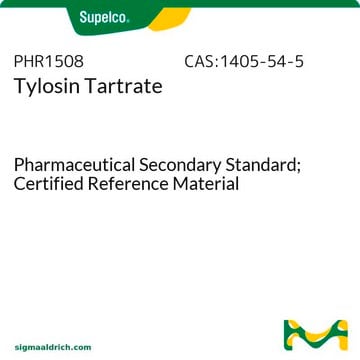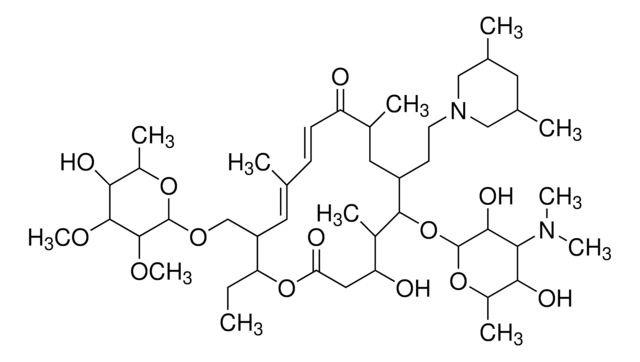T6134
Tylosin tartrate
potency: ≥800 units/mg tylosin
Synonim(y):
[R-(R′R′)]-2,3-Dihydroxybutanedionate Tylosin salt
About This Item
Polecane produkty
Postać
powder
siła działania
≥800 units/mg tylosin
warunki przechowywania
(Keep container tightly closed in a dry and well-ventilated place. Keep in a dry place.)
kolor
off-white to yellow
rozpuszczalność
H2O: soluble 50 mg/mL
spektrum działania antybiotyku
Gram-positive bacteria
mycoplasma
Tryb działania
protein synthesis | interferes
temp. przechowywania
2-8°C
ciąg SMILES
O[C@H]([C@@H](O)C(O)=O)C(O)=O.CC[C@H]1OC(=O)C[C@@H](O)[C@H](C)[C@@H](O[C@@H]2O[C@H](C)[C@@H](O[C@H]3C[C@@](C)(O)[C@@H](O)[C@H](C)O3)[C@@H]([C@H]2O)N(C)C)[C@@H](CC=O)C[C@@H](C)C(=O)\C=C\C(C)=C\[C@@H]1CO[C@@H]4O[C@H](C)[C@@H](O)[C@@H](OC)[C@H]4OC
InChI
1S/C46H77NO17.C4H6O6/c1-13-33-30(22-58-45-42(57-12)41(56-11)37(52)26(5)60-45)18-23(2)14-15-31(49)24(3)19-29(16-17-48)39(25(4)32(50)20-34(51)62-33)64-44-38(53)36(47(9)10)40(27(6)61-44)63-35-21-46(8,55)43(54)28(7)59-35;5-1(3(7)8)2(6)4(9)10/h14-15,17-18,24-30,32-33,35-45,50,52-55H,13,16,19-22H2,1-12H3;1-2,5-6H,(H,7,8)(H,9,10)/b15-14+,23-18+;/t24-,25+,26-,27-,28+,29+,30-,32-,33-,35+,36-,37-,38-,39-,40-,41-,42-,43+,44+,45-,46-;1-,2-/m11/s1
Klucz InChI
ICVKYYINQHWDLM-KBEWXLTPSA-N
Szukasz podobnych produktów? Odwiedź Przewodnik dotyczący porównywania produktów
Opis ogólny
Zastosowanie
Działania biochem./fizjol.
Antimicrobial Spectrum: This product acts against gram-positive bacteria and mycoplasma.
Komponenty
Przestroga
Inne uwagi
Hasło ostrzegawcze
Danger
Zwroty wskazujące rodzaj zagrożenia
Zwroty wskazujące środki ostrożności
Klasyfikacja zagrożeń
Resp. Sens. 1 - Skin Sens. 1
Kod klasy składowania
11 - Combustible Solids
Klasa zagrożenia wodnego (WGK)
WGK 3
Temperatura zapłonu (°F)
Not applicable
Temperatura zapłonu (°C)
Not applicable
Środki ochrony indywidualnej
dust mask type N95 (US), Eyeshields, Faceshields, Gloves
Certyfikaty analizy (CoA)
Poszukaj Certyfikaty analizy (CoA), wpisując numer partii/serii produktów. Numery serii i partii można znaleźć na etykiecie produktu po słowach „seria” lub „partia”.
Masz już ten produkt?
Dokumenty związane z niedawno zakupionymi produktami zostały zamieszczone w Bibliotece dokumentów.
Klienci oglądali również te produkty
Nasz zespół naukowców ma doświadczenie we wszystkich obszarach badań, w tym w naukach przyrodniczych, materiałoznawstwie, syntezie chemicznej, chromatografii, analityce i wielu innych dziedzinach.
Skontaktuj się z zespołem ds. pomocy technicznej













